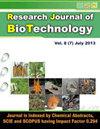叶苔生物活性的研究Grolle
IF 0.2
Q4 Biochemistry, Genetics and Molecular Biology
引用次数: 0
摘要
英语泛指(德诺)以郎槟榔为原料,提取其提取物,并对其生物活性进行评价。对四种提取物(正己烷、氯仿、乙酸乙酯和乙醇)进行抗氧化(铁还原力、DPPH和脂质过氧化)、酶促抑制(酪氨酸酶、α-葡萄糖苷酶和透明质酸酶)、MCF-7细胞毒性和植物化学筛选。在抗氧化能力方面,乙酸乙酯提取物具有最高的抗氧化能力,还原铁和清除DPPH能力,而氯仿提取物具有最高的抗脂质过氧化能力。在酶抑制评价方面,对酪氨酸酶的抑制能力不显著,而对α-葡萄糖苷酶和透明质酸酶的抑制能力较强,其中氯仿提取物对α-葡萄糖苷酶的抑制能力最好,乙酸乙酯提取物对透明质酸酶的抑制能力最好。出乎意料的是,正己烷提取物对MCF-7的增殖抑制效果最好。最后,植物化学筛选揭示了肝草提取物中存在重要的次生代谢物,如酚类化合物(酚类、醌类、香豆素和类黄酮)和苷类化合物(皂苷和心苷)。本文章由计算机程序翻译,如有差异,请以英文原文为准。
Investigation on the biological activity of the leafy liverwort Denotarisia linguifolia (De Not.) Grolle
Denotarisia linguifolia (De Not.) Grolle, or D. linguifolia, collected from LangBiang was used to make fraction extracts used for the evaluation of biological activity. Four extracts (n-hexane, chloroform, ethyl acetate and ethanol) were assessed for antioxidant (ferric reducing power, DPPH and lipid peroxidation), enzymatic inhibition (tyrosinase, α-glucosidase and hyaluronidase), cytotoxicity against MCF-7 and phytochemistry screening. For antioxidant assays, ethyl acetate extract had the highest antioxidant capacity ferric reducing power and DPPH scavenging, while chloroform extract had the highest antioxidant capacity in lipid peroxidation. For enzyme inhibition evaluation, D. linguifolia ability in anti-tyrosinase was insignificant while its ability in anti-α-glucosidase and anti-hyaluronidase was exceptional, chloroform extract had the best ability against α-glucosidase and ethyl acetate extract had the best ability against hyaluronidase. Unexpectedly, the n-hexane extract had the best potential for preventing the proliferation of MCF-7. Finally, the phytochemistry screening revealed the presence of important secondary metabolites within the liverwort extracts such as phenolic compounds (phenols, quinones, coumarins and flavonoids) and glycosides (saponins and cardiac glycosides).
求助全文
通过发布文献求助,成功后即可免费获取论文全文。
去求助
来源期刊

Research Journal of Biotechnology
工程技术-生物工程与应用微生物
CiteScore
0.60
自引率
0.00%
发文量
192
审稿时长
1.5 months
期刊介绍:
We invite you to contribute Research Papers / Short Communications / Review Papers:
-In any field of Biotechnology, Biochemistry, Microbiology and Industrial Microbiology, Soil Technology, Agriculture Biotechnology.
-in any field related to Food Biotechnology, Nutrition Biotechnology, Genetic Engineering and Commercial Biotechnology.
-in any field of Biotechnology related to Drugs and Pharmaceutical products for human beings, animals and plants.
-in any field related to Environmental Biotechnolgy, Waste Treatment of Liquids, Soilds and Gases; Sustainability.
-in inter-realted field of Chemical Sciences, Biological Sciences, Environmental Sciences and Life Sciences.
-in any field related to Biotechnological Engineering, Industrial Biotechnology and Instrumentation.
-in any field related to Nano-technology.
-in any field related to Plant Biotechnology.
 求助内容:
求助内容: 应助结果提醒方式:
应助结果提醒方式:


